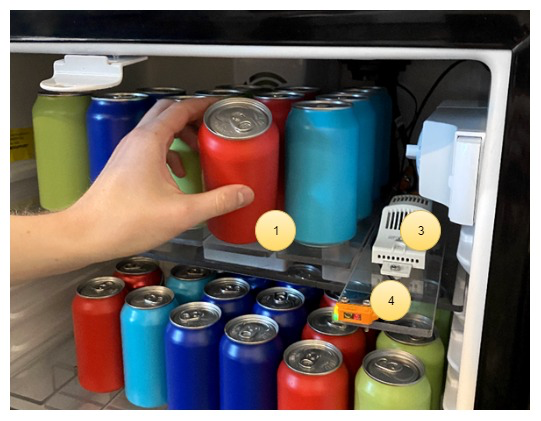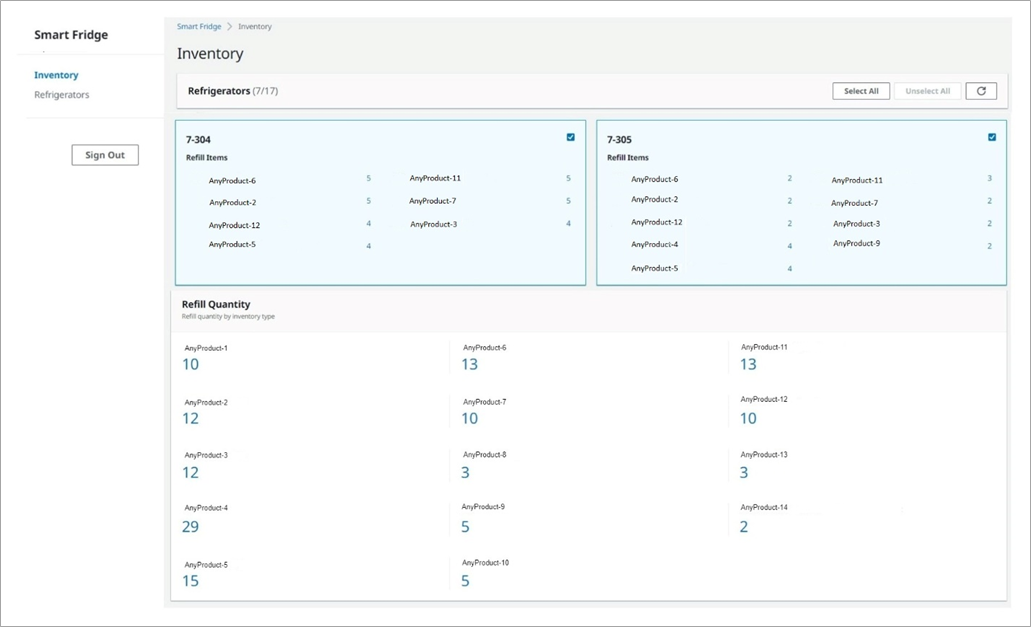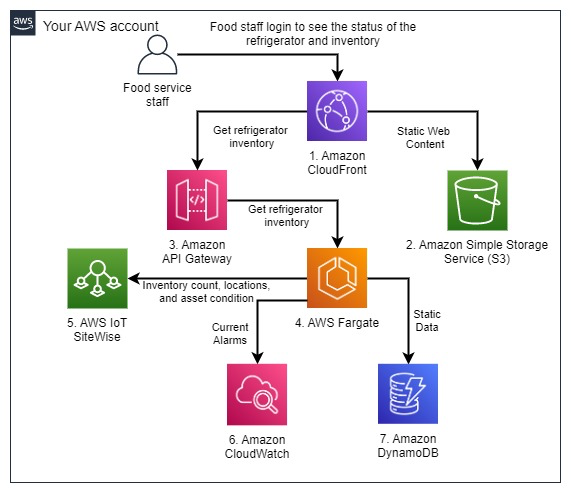AWS Partner Network (APN) Blog
How the AWS Executive Briefing Center Gets Real-Time Inventory and Asset Data with CloudRail and AWS IoT
By Bob Edmiston, Principal UX Researcher – AWS Industry Products
By Chris Morrissey, Sr. Software Development Engineer – AWS Industrial IoT and Edge
By Ram Gorur, Sr. Solutions Architect – Exec and AWS EBC
 |
| CloudRail |
 |
Monitoring inventory status and counts across various locations is key to inventory management. Internet of Things (IoT) sensors allow organizations to view and maintain the supply levels they need, when and where they need them, and ensure they are stored properly along the way.
Data derived from these sensors can be used to inform operations, like performing predictive maintenance on equipment or adapting inventory to plan fulfillment routes.
Whether you work in agriculture, hospitality, pharmaceuticals, retail, supply chain, transportation logistics, or another industry or domain, IoT data can provide necessary insights to help improve operational efficiency.
In this post, we describe how the AWS Executive Briefing Center (EBC) in Seattle is using AWS IoT sensor technology, along with integrations from CloudRail, an AWS Partner with a qualified hardware offering, to proactively monitor meeting room beverage inventory.
With a sample architecture, we demonstrate how our custom application, called Illuminate, has addressed the EBC’s inventory management challenges.
Managing Hospitality Scaling Challenges with Smart Refrigeration
At AWS global Executive Briefing Centers, customers have discussions with local AWS executives and experts about ways to advance their cloud journeys. EBCs allow customers to learn from AWS through immersive technical demonstrations designed to show how technology can help accelerate digital transformation.
One of the technical demonstrations at the Seattle EBC is the food service staff’s beverage inventory status solution that has been installed in each briefing room, enabled by IoT. Using both conventional analog and modern IO-Link industrial smart sensors, the solution collects inventory and operational data to help keep food service staff up to date on the status of each meeting room refrigerator.
Illuminate allows food service staff to avoid interrupting meetings to review or restock inventory. With the ability to remotely monitor refrigerators, employees can proactively detect issues like abnormal temperature and whether doors had been left open. This real-time inventory and asset condition monitoring capability allow staff to focus their time on high-value tasks instead of manually checking each briefing room multiple times per day.
Industrial IoT Gateway Technology from CloudRail
CloudRail produces a managed Industrial IoT (IIoT) gateway that allows customers to deploy IoT sensors to the cloud quickly and without code. Predictive quality, asset condition monitoring, and predictive maintenance are some of the many IIoT use cases that CloudRail enables.
With CloudRail, you can connect machines to AWS IoT Core in less than a minute. CloudRail’s database includes over 12,000 sensor definitions, and its service includes automated data transformations and device provisioning.
In need of a reliable, easily maintainable, and intuitive solution, AWS collaborated with CloudRail to capture, process, and send data from meeting room refrigerators to AWS IoT Core. CloudRail’s solution integrates with AWS IoT Core to analyze what equipment is doing, allowing operators to make informed business decisions.
Using Data Insights to Keep Shelves Stocked
The resulting smart refrigerator solution helps hospitality staff keep meeting rooms stocked with minimal workday disruption. Throughout the day, sensors installed in each refrigerator collect weight data for every row of beverages. The solution then divides the weight by the planned number of units per row and compares the result with a table containing the expected contents of the refrigerator.
Subtracting the resulting value from planned inventory provides the number of specific beverages required for replenishment. Real-time inventory and room schedule data is displayed on a large screen in the facility kitchen, where staff can get on-the-spot insight into the replenishment needs of each meeting room.
At the start of the day, the staff uses the solution’s all-up restock summary page to see exactly how many of each drink is needed to restock the entire facility. During opening duties, they simply load one large cart with exactly the number of beverages needed for all 16 meeting rooms and then restock all of them in one sweep.
IO-Link sensors from ifm and Stego also provide operational data, including internal air temperature, humidity, door state, compressor duty cycle, vibration, ambient air temperature, fan and compressor motor temperature, and vibration.
These measurements are stored in AWS IoT SiteWise and additionally passed as metrics to Amazon CloudWatch, where alarms are used to determine if the refrigerator doors are left open, if the products are being held at the right temperature, and if the motors have been operating normally.
EBC Smart Refrigeration Architecture
The purpose of this architecture is to demonstrate how Illuminate gives EBC food service staff real-time beverage inventory and refrigerator condition monitoring across briefing rooms.
Data is collected from IoT sensors in the refrigerators and is displayed to service staff on a large screen in the facility kitchen, giving them on-the-spot insight into the needs of each room.
Refrigerator Sensor Setup
Figure 1 is a diagram of the sample architecture, the components used to send data from refrigerators to AWS, and the AWS services used to present data to EBC food service staff.
Figure 1 – EBC smart refrigeration architecture.
The image below is a photograph of a fully assembled EBC briefing room refrigerator. This is labeled based on the descriptions of the components below, for you to reference as we describe each component. Under each type of beverage is a shelf which takes the weight of the beverages to determine the inventory.
On the right side of Figure 2, there are two sensors that track the temperature and whether the door is open. Figure 2a is a photograph of an analog to digital converter, IO-Link hub, and CloudRail IoT gateway. The components are described further in this post.
Figure 2 – Implementation: refrigerator view.
Figure 2a – Implementation: integration with IoT devices and AWS.
The diagram below in Figure 3 shows the sample architecture and components used to send data from refrigerators to AWS. Each component is labeled with a number corresponding to the explanation of each component.
- CALT Load Cell Weight Transmitter Amplifier JY-S60 Series: A load cell weight transmitter amplifier transmits a signal of the weight of items loaded onto it. The sample architecture uses load sensors to electronically record the current weight. Since each shelf has one type of beverage, the cumulative weight of inventory on each shelf can determine the current number of each type of beverage. Change in weight can signal that a beverage has been added or removed from the refrigerator shelf.
- ifm IO-Link input/output module: The IO-Link module is an analog-to-digital converter. The sample architecture uses this to convert the 4-20 milliampere(mA) signals from the load cell weight transmitter amplifier JY-S60 into a digital IO-Link signal.
- Stego Smart Sensor CSS 014: The compact Smart Sensor CSS 014 electronically records temperature and humidity and converts the measured data into a digital IO-Link signal.
- ifm Diffuse reflection sensor: The Diffuse reflection sensor electronically records the state of the refrigerator door and converts the measure data into digital IO-Link signal.
- ifm IO-Link hub: The IO-Link hub is a network device that connects up to eight IO-Link devices to a CloudRail gateway.
- CloudRail CloudRail.Box: The CloudRail.Box is an IoT gateway that sends sensor measurements to AWS IoT Core using the Message Queuing Telemetry Transport (MQTT) protocol. The CloudRail management service manages gateway firmware updates and security patches, reducing the need for IT staff to perform on-site software updates.
- AWS IoT Core: AWS IoT Core is used to transmit messages between all of your IoT devices and applications with low latency and high throughput. In the architecture shown, the sensor data is received in AWS IoT Core, processed, then forwarded to AWS IoT SiteWise and Amazon CloudWatch.
- AWS IoT SiteWise: AWS IoT SiteWise is a managed service that simplifies collecting, organizing, and analyzing industrial equipment data. The door state (open or closed) and refrigerator temperature are stored as metric properties on the refrigerator asset. The weight from the load sensor value is stored as a metric property on each shelf row asset. The shelf row asset contains a transformation that converts the load sensor value to an inventory count for that row.
- Amazon CloudWatch: CloudWatch collects and visualizes real-time logs, metrics, and event data in automated dashboards to streamline your infrastructure and application maintenance. This sample architecture uses CloudWatch alarms to notify food service staff if the door has been left open longer than 60 seconds or the internal temperature deviates outside the ideal product temperature range of 34-48 degrees Fahrenheit.
Figure 3 – Refrigerator data and measurements ingestion to AWS.
For context, Figure 4 is a photograph of the physical components described, each labeled with a number corresponding to the explanation of each component. There is a load cell weight transmitter amplifier, IO-Link input/output module, Smart Sensor CSS 014, Diffuse reflection sensor, IO-Link hub, and CloudRail.Box.
The figure below also shows an empty refrigerator shelf fully assembled with the sensors.
Figure 4 – IoT components used in the solution.
Diagram of the Illuminate User Interface
The Illuminate custom application gets data from AWS IoT SiteWise, CloudWatch, and Amazon DynamoDB to present to EBC food service staff on the Illuminate user interface (UI). EBC food service staff cross-references this data with the EBC calendar to refill briefing room refrigerators without interrupting meetings.
Figure 5 is a screenshot of the Illuminate UI. The Inventory page is selected, and it shows each refrigerator and the number of items to refill. It also shows a total refill quantity for each beverage type. EBC food service staff cross-references inventory data with calendar data so they don’t interrupt meetings to refill the refrigerators.
Figure 5 – Illuminate UI displaying inventory summary.
The next figure is a screenshot of the Illuminate UI. The Refrigerators page is selected, and it shows the refrigerator name, status, EBC briefing room, and the menu that indicates what product set should be stocked for that day.
Figure 6 – Illuminate UI displaying list of refrigerators monitored.
Figure 7 below shows the sample architecture and AWS services used to collect and present data on the Illuminate UI. Each component is labeled with a number which corresponds to the explanation of each component below.
- Amazon CloudFront: Amazon CloudFront is a content delivery network (CDN) service built for high performance, security, and developer convenience. This sample architecture uses CloudFront to cache the UI rendered to the food-service staff.
- Amazon Simple Storage Service: Amazon S3 is an object storage service offering industry-leading scalability, data availability, security, and performance. This sample architecture uses S3 to host the static website by configuring your S3 bucket for website hosting and then uploading your content to the bucket.
- Amazon API Gateway: Amazon API Gateway is a fully managed service that makes it easy for developers to create, publish, maintain, monitor, and secure APIs at any scale. This sample architecture uses API Gateway to publish an API for the Illuminate service.
- AWS Fargate: AWS Fargate is a serverless compute engine for containers. This application uses Fargate to run the Illuminate application. When a request is made by food service staff in the UI, the Illuminate application gets refrigerators’ latest inventory, temperature, and door state values, and presents the data to the EBC food service staff.
- AWS IoT SiteWise: AWS IoT SiteWise is a managed service that simplifies collecting, organizing, and analyzing refrigerator data. It ingests all of the sensor data and produces both inventory and refrigerator condition insights.
- Amazon CloudWatch: This application uses CloudWatch to collect and visualize real-time logs, metrics, and event data in automated dashboards to streamline infrastructure and application maintenance. This sample architecture uses CloudWatch alarms to notify food service staff.
- Amazon DynamoDB: Amazon DynamoDB is a fully managed, serverless, key-value NoSQL database designed to run high-performance applications at any scale. The DynamoDB table has data regarding the type of beverage on each refrigerator shelf.
Figure 7 – Illuminate application overview.
Enabling Ongoing Satisfaction and Growing Productivity
Since the Seattle EBC’s opening, the smart refrigerator solution has helped the EBC team provide seamless hospitality by making sure cold drinks never run out for guests. By eliminating the need to frequently check each room’s beverage inventory, the solution saved hospitality staff an estimated four hours of labor per day.
With CloudRail’s solution automatically connecting IO-Link sensors into the AWS IoT, the team was able to accelerate per-asset implementation from weeks to less than an hour. The entire solution was remotely provisioned by centralized IT teams.
After 18 months of scaled operation, not a single sensor or gateway has failed. The managed CloudRail gateways are updated and patched without staff involvement. The solution is being used by EBC staff daily, who love it for its time-saving usefulness.
Conclusion
In this post, we discussed how IoT can help with inventory and location monitoring. We explored CloudRail and AWS IoT capabilities, and how the AWS Executive Briefing Center (EBC) partnered with CloudRail to know the inventory count and equipment state for EBC briefing room beverage refrigerators.
With the Illuminate solution from CloudRail and AWS IoT, EBC food service staff keep meeting rooms stocked with cold drinks with minimal disruption to employee and guest productivity. Using the Illuminate user interface, EBC food service staff cross-reference data collected from refrigerator sensors with EBC calendar data to avoid interrupting meetings, streamline restocking routes, and monitor the state of the refrigerators.
IoT data like this can be used to inform operations, like planning predictive maintenance on equipment and adapting logistic routes based on inventory data.
The devices mentioned in this post are industrial-grade, but you can get started with any of CloudRail’s compatible sensors, including CloudRail’s recommended starter kit. You can get started with AWS IoT Core using the AWS IoT Core console, AWS IoT SDKs, or the IoT command line interface.
To learn more about AWS IoT services and solutions, and visit CloudRail to explore its fully managed plug-and-play solution that acquires data from industrial environments.
CloudRail – AWS Partner Spotlight
CloudRail is an AWS Partner that connects industrial sensors and actuators via a plug-and-play approach with the cloud.








